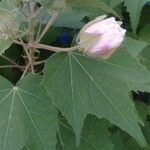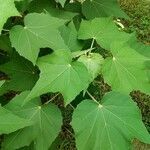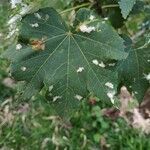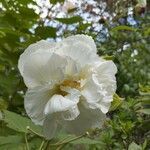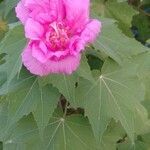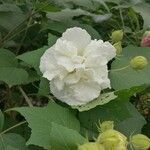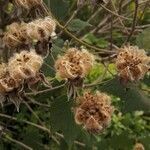Subshrubs, shrubs, or trees, to 8 m. Stems: new growth usually somewhat floccose, hairs stellate and simple or glandular, line of fine, curved hairs absent or obscured. Leaves: stipules subulate to narrowly triangular, 3–14 mm; petiole below inflorescence 1/2–1 1/2 blade, fine, curved hairs absent or obscured adaxially; blade broadly to transversely ovate, 3–7-lobed, 6–20 × 6.5–22.5 cm below inflorescence, base deeply to shallowly cordate, lobes broadly triangular, margins subentire to coarsely crenate-dentate, apex broadly obtuse to long-acuminate, surfaces variably stellate-hairy, sometimes minutely so, nectary absent. Inflorescences solitary flowers, in axils of distal leaves or appearing subcorymbose by reduction of internodes and subtending leaves. Pedicels obscurely to conspicuously jointed distally, 2–12 cm, stellate-and glandular-hairy; involucellar bractlets (6 or)7–11(or 12), often deciduous after anthesis, linear-subulate to narrowly triangular, 0.8–2.2 cm, margins not ciliate, stellate-and glandular-hairy Flowers horizontal or ascending, sometimes double; calyx divided 1/2–2/3 length, campanulate, 1.6–4 cm, lobes triangular, apices acute to acuminate, stellate-and glandular-hairy, nectaries absent; corolla broadly campanulate to rotate, petals usually opening white, changing to deep pink over course of day, rarely pink and unchanging, often with deep pink spot near base, ± obovate, (2.5–)4–7.5 × 1.2–7.5 cm, apical margins repand, usually undulate, finely hairy abaxially where exposed in bud; staminal column straight, white to pink, 1.4–2.6 cm, bearing filaments nearly throughout, free portions of filaments not secund, 2.5–5 mm; pollen cream to yellowish orange; styles white to pink, 3–16 mm; stigmas pink or yellow, rarely white. Capsules brown, broadly ovoid or globose, 1–2.5 cm, apex impressed, strigose. Seeds olivaceous to reddish brown or dark brown, reniform-ovoid, 2–2.8 mm, laterally glabrous, dorsally and dorsolaterally bearing long, straight, light brown to white, simple or 2-or 3-armed hairs. 2n = 84, 88, 92, 100, 110, 120 (all cultivars).
Shrubs or small trees, erect, 2-5 m tall, deciduous. Branchlets, petioles, pedicel, epicalyx, and calyx densely stellate and woolly pubescent. Stipules lanceolate, 5-8 mm, usually caducous; petiole 5-20 cm; leaf blade broadly ovate to round-ovate or cordate, 5-7-lobed, 10-15 cm in diam., papery, abaxially densely stellate minutely tomentose, adaxially sparsely stellate minutely hairy, lobes triangular, basal veins 7-11, margin obtusely serrate, apex acuminate. Flowers solitary, axillary on upper branches. Pedicel 5-8 cm, articulate near end. Epicalyx lobes 8, filiform, connate at base, 10-16 × ca. 2 mm. Calyx campanulate, 2.5-3 cm, lobes 5, ovate, acuminate. Corolla white or reddish, becoming dark red, ca. 8 cm in diam.; petals nearly orbicular, 4-5 cm in diam., hairy abaxially, barbate at base. Staminal column 2.5-3 cm, glabrous. Styles 5, pilose. Capsule flattened globose, ca. 2.5 cm in diam., yellowish hispid and woolly; mericarps 5. Seeds reniform, villous abaxially. Fl. Aug-Oct.
A shrub which loses its leaves during the year. It grows to 3 m high and spreads to across. The stem is erect and branching. The stem is covered with soft, star shaped hairs. The leaves are large and oval and divided like fingers on a hand and have 3-7 pointed lobes. The leaves can be 17 cm long. The flowers are funnel shaped and white and turn deep pink in a day. They can be double or single. They are 10 cm across. There are some named varieties.
Large shrub. Leaves suborbicular, 5-7-angled. Flowers large, 80-100 mm in diameter. Epicalyx with bracts free. Calyx much enlarged in fruit, not scarious, lobes united for a third of their length. Flowers white at first, turning red.
A large shrub with suborbicular 5–7-angled leaves and large flowers 8–10 cm. in diam., opening white and turning red by evening.
